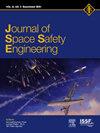Attitude estimation from photometric data using Gaussian process regression
IF 1.7
Q3 ENGINEERING, AEROSPACE
引用次数: 0
Abstract
The rapid growth of resident space objects in Earth’s orbit has intensified the need for advanced space situational awareness and space domain awareness to manage satellite traffic and prevent collisions. Attitude estimation is critical for accurate state propagation, as non-gravitational forces like solar radiation pressure and atmospheric drag depend on the object’s attitude. This study explores using light curves, time variation of an object’s brightness, to estimate a space object’s attitude. Light curve inversion, traditionally used in astronomy, faces challenges when applied to resident space objects due to their non-convex shapes and specular reflections. Conventional methods for attitude estimation often assume known shape and surface parameters, which are usually unknown for space debris generated by a collision or breakup. To address this issue, this study proposes the estimation method combining Gaussian process regression with the unscented Kalman filter. This study uses Gaussian process regression for a non-parametric observation model, enhancing robustness against unknown surface parameters. Numerical examples consider a box-wing object in a geosynchronous orbit and demonstrate that the proposed method has better estimation accuracy than a conventional unscented Kalman filter. The numerical simulation results also represent the attitude estimation robust against uncertainties in surface properties, contributing to practical scenarios in space situational awareness and space domain awareness where the object parameters are unknown.
利用高斯过程回归对光度数据进行姿态估计
地球轨道上驻留空间物体的快速增长,加强了对先进空间态势感知和空间域感知的需求,以管理卫星交通和防止碰撞。姿态估计对于精确的状态传播至关重要,因为太阳辐射压力和大气阻力等非引力取决于物体的姿态。这项研究探索了使用光曲线,即物体亮度的时间变化,来估计空间物体的姿态。传统上用于天文学的光曲线反演,由于其非凸形状和镜面反射,在应用于驻留空间物体时面临挑战。传统的姿态估计方法通常假定已知的形状和表面参数,而对于碰撞或破裂产生的空间碎片来说,这些参数通常是未知的。针对这一问题,本文提出了高斯过程回归与无气味卡尔曼滤波相结合的估计方法。本研究将高斯过程回归用于非参数观测模型,增强了对未知表面参数的鲁棒性。以地球同步轨道上的一个箱翼目标为例,数值算例表明,该方法比传统的无气味卡尔曼滤波具有更好的估计精度。数值模拟结果也表明姿态估计对表面特性的不确定性具有鲁棒性,有助于在物体参数未知的空间态势感知和空间域感知中实现实际场景。
本文章由计算机程序翻译,如有差异,请以英文原文为准。
求助全文
约1分钟内获得全文
求助全文
来源期刊

Journal of Space Safety Engineering
Engineering-Safety, Risk, Reliability and Quality
CiteScore
2.50
自引率
0.00%
发文量
80
 求助内容:
求助内容: 应助结果提醒方式:
应助结果提醒方式:


